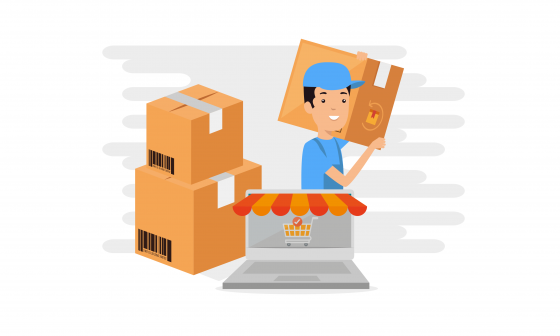Today, most people shop online — instant gratification being a significant determining factor. The addition of discounts, promotions, coupons have made this mode the easiest and most streamlined by far. eCommerce is on the rise. Statista demonstrates how 67% of millennials prefer shopping online while 41% of baby boomers and only 28% of seniors prefer online shopping.
Total retail sales in the United States in Trillions
Source: https://www.statista.com/statistics/443495/total-us-retail-sales/
Hence, to paraphrase Mark Twain, “rumors of the death of brick and mortar retail are greatly exaggerated”. eCommerce shopping does continue to grow rapidly but brick and mortar stores are still holding up well since many people still prefer the in-store shopping experience where they can try out products before committing to a purchase.
However, for many of these eCommerce brands, the bulk of their yearly revenue comes from the holiday months. Accenture data reveals that Millennials are likely to the biggest spenders this holiday season. When it comes to creating effective, meticulous holiday campaigns, brands need to start early, plan ahead and be prepared to stay ahead of the curve.
USPS projects shipping at least 16 million packages and mail during the 2019 holiday season. Auditshipment’s BFCM 2019 FedEx-UPS delivery report, in fact, reveals an increasing number of retailers offering the ‘Next Day Delivery’ option. This comes as no surprise when retail giants like Target and Amazon are shrinking order fulfillment timeline. A whopping 67% of packages were shipped using FedEx-Next Day-End of day service type.
By deciding on the right shipping solution, merchants can easily make shipping anxiety a stressor of the past not just for themselves but also for their customers. More than 700 million FedEx and UPS packages were shipped between November 24th and December 31st in 2019. Hence, choosing an optimal shipping strategy has a big impact on revenue, delivery quality and arrival times.
Online buyers demand faster deliveries
Every business strives to meet customer’s expectations and delivery requirements. These expectations, fortunately, are pretty simple- orders should arrive on time and be shipped accurately. Companies struggling to meet deadlines upstream in their supply chain, however, can find this extremely challenging. Consistent problems with poor OTD performance impacts more than customers and can cause issues that will affect many areas of a company’s supply chain including avoidable expedited shipping costs, production delays due to material shortages and being overwhelmed with customer complaints.
For the sake of your convenience, Auditshipment has built a non-biased analytical report on FedEx and UPS deliveries during the BFCM season that will tell you everything you need to know about the holiday rush and how to strategically tackle it.
Significance of On-time delivery in the age of eCommerce hyper-growth
The challenge for eCommerce business when it comes to customer satisfaction is unique since you may not directly interact with the customers at all throughout the buying process. Hence, tangible aspects of your business become crucial- delivery being the most important among them. It is a key indicator of the last-mile delivery efficiency of any eCommerce business.
Source: https://www.userzoom.com/blog/ecommerce-ux-trends-2019/
With holidays, the opportunities to flourish are endless, but so is the opportunity for shipping error. For instance, just the last holiday season almost 16 million pieces of packages were delivered. 8% of those were delayed between UPS and FedEx alone.
A shipping delay will affect your relationship with the customers and also destroy the chance for repeat sales. Thanks to the seeding of online reviews and rating sites, dissatisfied customers’ voices will be heard by other customers and them turning their backs on you can be detrimental to your business.
Therefore, adherence to the delivery date and promise time is highly significant to the survival of eCommerce companies. And those who fail to meet the promised delivery date during the peak holiday season will have a long way to reach its potential.
Speeds up your cash flow
When packages are delivered on time, especially during the holiday season when demand is sky high, the implication is your supply chain is working at optimal efficiency. Since there is little or no room for delay from the moment your client completes their order until the package arrives at their door, on-time deliveries are extremely important for business owners. A prompt and efficient process only translates to prompt and efficient payment.
Boosts Reputation
A good, positive hassle-free customer experience may not be shared widely on social media but if they have a bad one they are likely to tell everyone about it. Delayed deliveries in particular. Making sure you deliver on time and get the basics right is key to building a reputation as a credible, trusted business. Thus, the brand image of a product is automatically enhanced when it’s delivered on time.
Say goodbye to breaches of contract
In very many business arrangements, you are contractually obligated to deliver products within stipulated, defined timeframes- Amazon for instance. Thus if you have an efficiently streamlined delivery solution in place- often through outsourced logistics- only means you will be able to guarantee regular, timely deliveries and avoid fines or repercussions.
Enhanced efficiency attracts new customers
What does on-time delivery imply? That every procedure of the delivery is efficient from its distribution of storage, the means of transportation and assigning routes, the logistics plans, practical delivery management and schedule to the right personnel in-charge. Punctual delivery is marked as the first important test with new customers. Delivery happens to be the first direct interaction between the company and new customers besides the inherently good values. Thus this becomes a fundamental requirement under any circumstances and companies of punctual shipments will naturally have good impressions, in addition, to open gates to other transactions with consumers.
Measuring On-Time delivery
Different organizations have devised different ways of measuring on-time delivery, it is the calculation of the total amount of shipments delivered on time to the customer in relation to the total number of orders shipped. Analyze the results, if the number is below the benchmark it means there are issues that have to be addressed right away. The time taken to deliver a shipment relies greatly on the location. The proximity of FedEx or UPS distribution centers determines the delivery speed of the order. Some destinations have a larger share of shipping volume as well as shipping delays compared to others.
For FedEx, Illinois(10.19%), Florida(8.90%) and Texas(8.19%) top the shipment destinations that experience a greater percentage of parcel delays. Besides these, the other states averaged around 4% delivery delays- California at 4.99%, New York at 4.10%, Colorado and Pennsylvania at 3.46% and 3.24% respectively.
For UPS packages, the distribution of delay was far from uniform. Among the UPS packages shipped to California, 10.12% of them were delayed. While for Ohio it was 4.61%, for Texas 4.14% and for Illinois 3.34%. The other states averaged around 2% of delays.
Download AuditShipment’s BFCM 2019 Report here
There are also delays across service types- arguably choosing the right shipping mode is the most challenging part of delivery- balancing cost and speed can be tricky. The time taken for a parcel to be shipped in the express mode may be equivalent to having it shipped through the ground. 17.48% of FedEx overnight packages were delayed during the weeks leading to Black Friday and Cyber Monday while 11.23% of FedEx Express packages were delayed.
The statistics are very different however for UPS shipments. There was a noticeably high delivery delay percentage for express (8.48%) when compared to the ground (4.28%) or standard deliveries (3.93).
According to Auditshipment’s report, however, air services had a significantly higher number of delays compared to the ground – 11% of UPS air early shipments were delayed during the black Friday and Cyber Monday sales period.
Delay reasons
Almost 50% of the delivery delays are caused by the operational inefficiency of the shipping carrier. Service level breakdown due to carrier performance is the topmost reason for delay among others like customs delay, incorrect address, customer not being available or business being closed (for UPS 23.80% of packages were delayed for this), weather delay etc. However, you can now easily claim your shipping costs in the form of refunds from FedEx and UPS with both offering money-back guarantee.
Here are some of the predictions for December deliveries
- With a growing number of cities snowed under, a 2%-3% increase in the number of FedEx and UPS package delay is likely.
- The rise in last-minute shopping will result in a disproportionate increase in the number of delays in Express and Overnight deliveries.
- At least 8% of oversize packages are likely to be delayed during this holiday season.
You put in a lot of effort ensuring your customers have a happy, positive experience. One shoddy delivery experience can ruin them all.
For eCommerce businesses, shipping constitutes an 8%-10% of total revenue in sales. To capture the holiday moments that matter, retails must measure key delivery metrics and enhance their on-time delivery efficiency. Navigating through the maze of order delivery exceptions is a logistics nightmare. But with the right order delivery insights and continuous incremental changes to your logistics strategy, it could turn into the customer acquisition channel.






